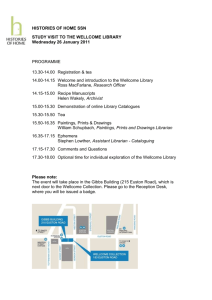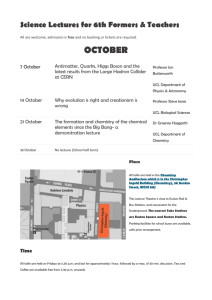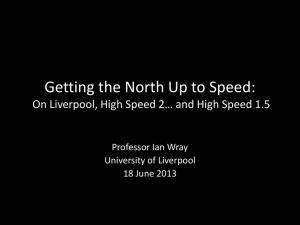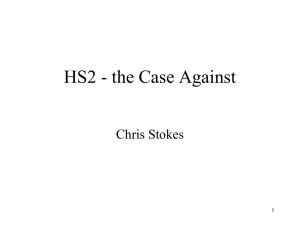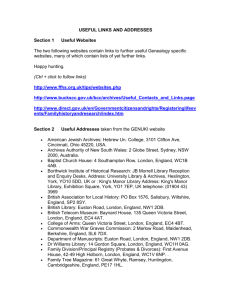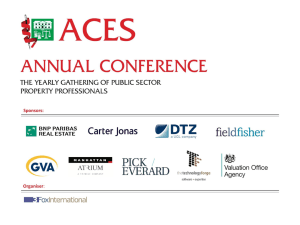Euston Cross description
advertisement
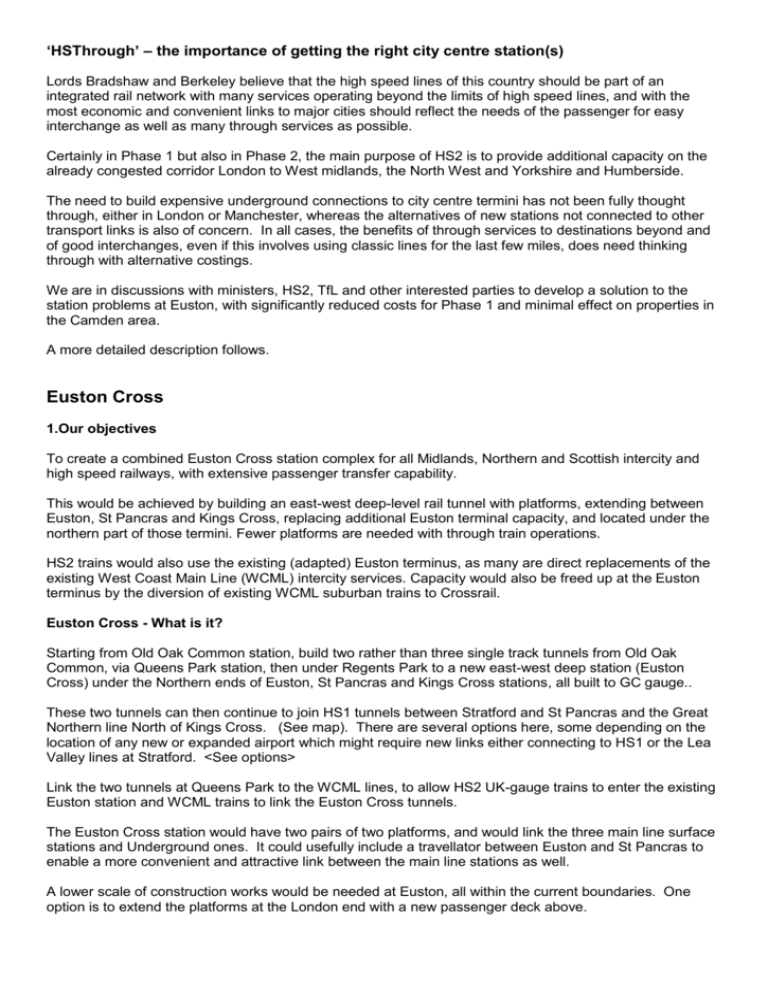
‘HSThrough’ – the importance of getting the right city centre station(s) Lords Bradshaw and Berkeley believe that the high speed lines of this country should be part of an integrated rail network with many services operating beyond the limits of high speed lines, and with the most economic and convenient links to major cities should reflect the needs of the passenger for easy interchange as well as many through services as possible. Certainly in Phase 1 but also in Phase 2, the main purpose of HS2 is to provide additional capacity on the already congested corridor London to West midlands, the North West and Yorkshire and Humberside. The need to build expensive underground connections to city centre termini has not been fully thought through, either in London or Manchester, whereas the alternatives of new stations not connected to other transport links is also of concern. In all cases, the benefits of through services to destinations beyond and of good interchanges, even if this involves using classic lines for the last few miles, does need thinking through with alternative costings. We are in discussions with ministers, HS2, TfL and other interested parties to develop a solution to the station problems at Euston, with significantly reduced costs for Phase 1 and minimal effect on properties in the Camden area. A more detailed description follows. Euston Cross 1.Our objectives To create a combined Euston Cross station complex for all Midlands, Northern and Scottish intercity and high speed railways, with extensive passenger transfer capability. This would be achieved by building an east-west deep-level rail tunnel with platforms, extending between Euston, St Pancras and Kings Cross, replacing additional Euston terminal capacity, and located under the northern part of those termini. Fewer platforms are needed with through train operations. HS2 trains would also use the existing (adapted) Euston terminus, as many are direct replacements of the existing West Coast Main Line (WCML) intercity services. Capacity would also be freed up at the Euston terminus by the diversion of existing WCML suburban trains to Crossrail. Euston Cross - What is it? Starting from Old Oak Common station, build two rather than three single track tunnels from Old Oak Common, via Queens Park station, then under Regents Park to a new east-west deep station (Euston Cross) under the Northern ends of Euston, St Pancras and Kings Cross stations, all built to GC gauge.. These two tunnels can then continue to join HS1 tunnels between Stratford and St Pancras and the Great Northern line North of Kings Cross. (See map). There are several options here, some depending on the location of any new or expanded airport which might require new links either connecting to HS1 or the Lea Valley lines at Stratford. <See options> Link the two tunnels at Queens Park to the WCML lines, to allow HS2 UK-gauge trains to enter the existing Euston station and WCML trains to link the Euston Cross tunnels. The Euston Cross station would have two pairs of two platforms, and would link the three main line surface stations and Underground ones. It could usefully include a travellator between Euston and St Pancras to enable a more convenient and attractive link between the main line stations as well. A lower scale of construction works would be needed at Euston, all within the current boundaries. One option is to extend the platforms at the London end with a new passenger deck above. It would be preferable to divert some of the WCML slow line trains directly into Crossrail at Old Oak common to reduce passenger flows at Euston. . There would be no HS1-2 link from Primrose Hill to York Way, currently proposed by HS2 with severe impact through Camden. Options East of Euston Cross station Through services on the Euston Cross lines would include the international services (not stopping there), extended Javelin services to the west or NW, and other domestic services such as identified in the Greengauge 21 Report to create An East West Thameslink. It would also be the station for the double deck HS2 trains. Some would continue to destinations on HS2 in Kent, but some would need to terminate there. A stabling facility for these trains is therefore needed to reduce the dwell time at the platforms; this could either be in two stub tunnels east of Euston Cross or on the east side of the GN line between Kings Cross and Arsenal ground. It is thought that Temple Mills would not have the capacity for them, and would also take up scarce capacity on HS1. Option 1 – direct tunnel link to connect to HS1 by step plate junctions in the Highbury area. With just this option, the stub tunnel stabling option would be necessary. Option 2 – link the existing HS1 connection to the North London Line, and divert this into a spiral tunnel connecting the East end of the Euston Cross station. The benefit of this is that it does not affect existing HS1 services; the existing link is built but not yet signalled. The link to the North London Line would be removed and reconstructed as a tunnel going below that line in the spiral. <map or diagram> Option 3 – in addition to constructing the ‘spiral’ also make a connection to the North on the East side of the GN lines where there is a disused formation. This could accommodate stabling for one or two double deck trains, as well as a connection to the GN lines to allow for through running from Peterborough or Cambridge through Euston Cross to stations NW or West. <map or diagram> Can it be built? Two months’ work by engineers has not found any show stoppers, either in relation to conflict with other tunnels and services, or in respect of construction under Somers Town between Euston and St Pancras. From the west, tunnels from Old Oak common would follow roughly the same lines as HS2s’ proposals, but be moved a little northward to form the link to and from the WCML between Kensal Rise and Queens Park stations. Construction can be achieved within the railway land ownership. The two Euston Express tunnels continue under Regents Park to the Euston Cross station. The station, four tunnels (two platforms and two pedestrian circulation tunnels) in each direction would be built under Somers Town as tunnels from work sites outside the area, similar to those planned for Crossrail 2. Crossrail 2 has already identified tunnelling options under Somers Town which do not require major demolition. The preferred option for both works is to locate the tunnels and station at levels below the rail subsurface liens but above the tube lines in the area. East of the Euston Cross station, there are several options for linking the tunnels and tracks with existing lines, generally in tunnels. A link with HS1 would require a step plate junction construction which could be built with minimal disturbance to HS1 traffic. Costings of construction Unfortunately, we have severe doubts about costs and buildability quoted at our informal meetings with HS2. We rely on figures from TfL and other industry engineers as well as our own experience. How will it work. HS2 has foreseen its timetable as 10 trains per hour (tph) covering ex-WCML flows, and 6 tph covering exEast Midlands and ECML flows. Up to 12 trains per hour are foreseen on the ‘classic’ WCML, excluding the 8 suburban trains diverted to Crossrail 1 from near Willesden Junction. (see article on HS2 and WCML services in pp75-77 of Modern Railways, March 2013) <link>. London Overground trains to Euston (3 tph) may or may not continue, or be diverted via Camden Road to Stratford. Freight on the WCML does not go East of Willesden. This is a combined total of 28 tph approaching Euston, to be directed at Queens Park between the 2 pairs of approach tracks to Euston terminus (WCML slow and WCML fast) and the Euston Cross tunnel, an average of 9-10 tph per track. The through tunnel design for Euston Cross should accommodate a higher proportion of the total train volume. Euston Cross station would have two platforms in each direction, all built to accommodate double deck trains. It would not be expected that international trains would stop there, since Eurostar trains will continue to operate from St Pancras. This is similar to the arrangement at Berlin Hauptbahnhof, where trains to the same destination often use either the high or low level platforms. Continuation of the Euston Cross trains to other destinations or to reverse at one of the stabling sidings Woude be necessary to reduce dwell time at the station and increase its hourly capacity. The onwards links could be one of the options to link with HS1 and the GN, including a connection towards tracks to whichever non-Heathrow airport was selected as Britain’s new hub. There is a continuing problem wit across the network with station platform heights and widths which will need resolving, whatever the routes and stations services by trains using HS2. With such a wide variation of dimensions, it is essential for cost and operational flexibility that trains rather than station platforms are adapted. Would the lengths of current Euston station platforms be sufficient for HS2 trains? Details of these HS2 trains are not yet available; only a few platforms are capable of taking the 16 car sleeper services, but the existing platforms could probably be lengthened at the London end to take the continental length of two ICE or TGV train formations if these are thought necessary. This might best be done by completing the deck over Euston station and use for distribution of passengers in place of the current end of train access. There is also space within the Euston land area to construct at least four additional platforms, on the sites of the wider ones built to accommodate postal or freight traffic. HS1 capacity: With all the trains running within a narrow speed band (140-186 mph) the capacity of HS1 should be capable of being enhanced to the same as HS2, i.e. 16 trains per hour per direction. Local impact Environmental impact and residential impact would be less at Euston though passenger handling would still need to be addressed at this London station and related passenger links at St Pancras and Kings Cross. Interchange handling would be easier by spreading the flows through three London stations and onto all their distribution networks including Thameslink. The Kensal-Queens Park area would experience some additional impact because of the WCML connections to/from the HS2 tunnel, though this would be compensated by no impact in the Primrose HillCamden Road area as is currently expected. There would be new intermediate ventilation and emergency exit shafts at different locations to the present proposal. The Old Oak Common eastbound HS2 tunnel design would be simpler. Economic and civic benefits Euston Cross would create a modern interchange hub for the central London, with excellent links between the three main line stations, and with Underground, similar to Berlin Hauptbahnhof, Paris Chatelet les Halles etc. It retains city centre terminus location, as preferred by HS2, and also allows through services across London to Stratford and beyond, helping regeneration of the eastern parts of London and Kent. Stratford is closer to Canary Wharf than Euston and is the hub for the east of London where economic regeneration is likely to be greater in the future compared with the west. It would provide Improved Underground interchange at Euston Cross, allowing dispersal from HS2 to Thameslink the Piccadilly Line as well as existing tubes and Crossrail 2. It retains good connections to Crossrail and other lines at Old Oak Common, as well as good interchange to Heathrow and wherever a future UK airport hub is located. There would be no need to demolish 500 properties West of Euston station, and no need for intrusive new line at Camden Road to connect HS1 to 2. Delivering our plan We urge a phased approach – save money and time to start with, so that the all-important London end is thought through, debated and got right! Given the need for more detailed engineering and planning of Euston Cross, we suggest ways of proceeding with the bulk of HS2 Phase 1, but using the existing Euston Station as the London terminus, with the few planned international trains using the existing North London line and the link to HS1 built but so far not used. This more phased build up is in line with what happened when high speed lines were introduced on the continent; they generally used (and often still do) existing stations to avoid the high costs of building new lines in urban environments. This would save at least £1 bn and allow time for discussion as to the optimum solution to cope with growth from Phase 2 of HS2 and, at the same time, start introduction of east/west ‘Thameslink’ type services (eventually to incorporate the current Javelin ones that terminate at St Pancras). By reducing and making small changes to the proposed Hybrid Bill, this would not cause any delay to the project. It would also ensure that the right decision is made for the all-important London end without delaying the rest of the project. Save £1 bn+ by: - Deleting the HS2-1 connection. It is not fit for purpose as currently proposed, is not guaranteed to be suitable for major regional access to whatever airport(s) are supported by the Davies Commission, and will have a very poor value for money – and at risk in the Phase 1 Hybrid Bill Select Committees. International trains of Eurostar size (UK loading gauge) can initially use the existing tracks between WCML and HS1, and the Euston Cross tunnels when built later (we don’t see that they should call at Euston Cross, they can serve Oak Old/Stratford).. - Deleting the works west of Euston station. There is space for building four or five more platforms at Euston within the shed, and/or of diverting some of the WCML suburban services onto Crossrail, thereby relieving pressure on the Underground services there. We believe that, with tighter turnround, this is more than adequate to cater for the Phase 1 and remaining WCML trains. We have ideas for developing Euston station to take longer trains and with better passenger facilities, all of which need discussing. - Deleting the HS2 tunnels from Queens Park area to Euston. HS2 trains would sue the existing Euston approaches from Queens Park. - Deleting the double deck trains for Phase 1. These are not required for the initial Birmingham service, being confined as they are to HS2 tracks. However we don’t rule out adaption of the existing approach tunnels to Euston terminus in Phase 2, to allow double-deck trains to reach the buffers there. There are approach four tunnels with currently six tracks, so there are options available without needing major new build. What this means We suggest that the parliamentary bill for Phase 1 should extend only to the proposed link with the WCML at Queens Park, and excluding any part of the HS1-2 link or alterations around Euston station. Phase 1 of the HS2 project is all about capacity. Look upon HS2 as the fifth and sixth track on the London to W Midlands corridor for congestion relief, noting the increase in demand for passenger and freight traffic (>double in 20 years). Use only single deck trains to UK loading gauge, preferably with tilt to enable journey times to and from Glasgow to be improved. Make network as interoperable as possible, even allowing Pendolinos on HS2 with necessary lineside and in-cab signalling modifications. There should be capacity at Euston for three or four more hourly services if turnarounds are improved there, and there is the option of adding more platforms within the existing shed – which has some excessively wide platforms previously designed for road vehicle servicing. For outer suburban services, these would preferably be diverted into Crossrail, but could continue as at present into Euston. Overall there is considerable additional train and passenger capacity achievable upstairs at Euston. The limited international services of only a few services a day proposed for the early years could use the current route from WCML to Camden Road and to HS1, if designed to Eurostar/UK loading gauge. Project timings To change the station arrangements at the London end or elsewhere would probably add two years to the project. However, it is understood that the HS2 Euston construction project is on the critical path so other sections might be able to be opened sooner. Construction of the tunnels between Old Oak Common and Queens Park would need to be completed physically since tunnel boring is required to start at OOC. However the Euston Cross route and tunnels could be constructed from a tunnel boring site at Queens Park or Willlesden so could be timed independently of the rest of HS2 phase 1. So OOC to HS1 via Euston Cross could be a separate hybrid bill, or added to the existing one if that gets delayed due to a decision to include the northern ‘Y’ parts in it as well. Overall, there is no reason why a new layout at the London end should delay the start of services at least from OOC to Birmingham and the North West. Study and debate Euston Cross. The next year or two should be used to study in more detail: Preferred links and station to connect with HS1 and possibly other lines, decisions on which may have to await the Davies Commission report on airports. This link could also provide inter-regional domestic services between such places as Peterborough, Southend, Stansted, Kent and Milton Keynes, Northampton and the Midlands, for which Greengauge 21 has provided evidence of strong demand. These regional connections could, unlike Crossrail 1 and 2, significantly reduce M25/M40 and M1 traffic, so benefiting the London & Home Counties economy and the pressures on other transport infrastructure. However, we are persuaded that a properly designed through station under Euston – St Pancras is very much preferable for the passengers and operators to an enlarged terminus. The simple fact is that Euston HS2 as currently envisaged merely perpetuates the Victorian (or even Georgian!) view that trains from the Midlands should end in NW Central London, which is very hard to access from these catchments – whereas in the 21st Century, the London eastern and south-eastern hinterland, and Anglia and Kent, are now 18% of England’s total population and probably 25-30%% of its economic output. To continue to have an infrastructure blockage for a large part of England’s economic powerhouse is totally unacceptable, especially if HS2 is to add value for the rest of the 21st Century and the whole of the 22nd. The stakeholders of Kent, Anglia, E&SE London and along the West Corridor are already saying loudly that this is fundamentally wrong – direct connectivity is vital. The north-south example of Thameslink’s success and its current expansion commitments towards 24 through trains per hour, provides a direct comparator for the current opportunity with HS2-HS1 to become a regional and national east-west express with quality interchanges along its route. We don’t see any decision to review again Euston’s final shape and then acquiring the necessary powers in Phase 2, as a hindrance. On the contrary, it will allow: - best commercial and public realm design for the area; - best consideration of how HS2-HS1 in a new format can address domestic London & Home Counties regional travel as well as identifying and refining initial (Greengauge 21) thinking on crossLondon domestic Intercity services; - best ways of relieving the passenger volume stresses at Euston caused by an over-dependence on terminating the vast bulk of UK Intercity trains in one station; - generate stakeholder support for HS2 because of the wider economic gains thereby created – including direct economic linkages between Kent/Anglia and the Midlands and the North – no longer dependent on and subservient to London; - a strong London area basis for backing the Phase 2 Hybrid Bill – instead of few apparent gains with that Bill – and with the ability once the Bill has been approved by Parliament to accelerate the Euston area works into the recently-started Phase 1 construction, thereby minimising the total delivery time in the Euston area while maximising benefits. Key benefits of Euston Cross Key wins are: • Greater national and London/Home Counties economic capacity: avoids most economic negatives caused by land take in the Euston area. • Largely cost-neutral: omits many current HS2 proposed works including high-risk elements, substitutes others. • Capability of phased development: eases financial pressures on national economy. • Environmentally much stronger compared to current HS2 proposals: Less residential and business disturbance and land take throughout Euston and Camden. • No harmful impact on existing North London Line: safeguards passenger and freight operations. • Avoids the current poor value for money HS2-HS1 scheme: with its low capacity and inability to be used by domestic services. • Maximises international connectivity: direct passenger links between Euston and St Pancras. • Option to reduce Old Oak interchange costs and complexity: potential to omit international platforms and include them within Euston Cross, if separate platforms are still necessary. • A surface access solution for many airport hub and expansion schemes: supports projects currently being considered by the Davies Commission. • Capacity for through domestic, as well as international, trains: between HS2/WCML and East London/Kent/East Anglia. • Through trains achieve stronger economic benefits east of Central London: within the East & SE London, East Anglia and Kent priority growth areas. • Future-proofed cross-London east-west rail capacity beyond Crossrail. • Other passenger benefits: o a national intercity passenger hub for Central London, serving all Midlands, North, Central and North Wales, and Scottish destinations o full integration of northern main line intercity and high speed routes with minimal disturbance to passengers’ familiarity with stations (Euston Cross would be accessible from all three existing termini) o relief of interchange pressure at Euston as HS2 load is distributed also across St Pancras and Kings Cross o o direct Crossrail-WCML services for London and Home Counties commuters direct London & Home Counties regional services, eg Milton Keynes-Kent. Bill Bradshaw/Tony Berkeley October 2013
